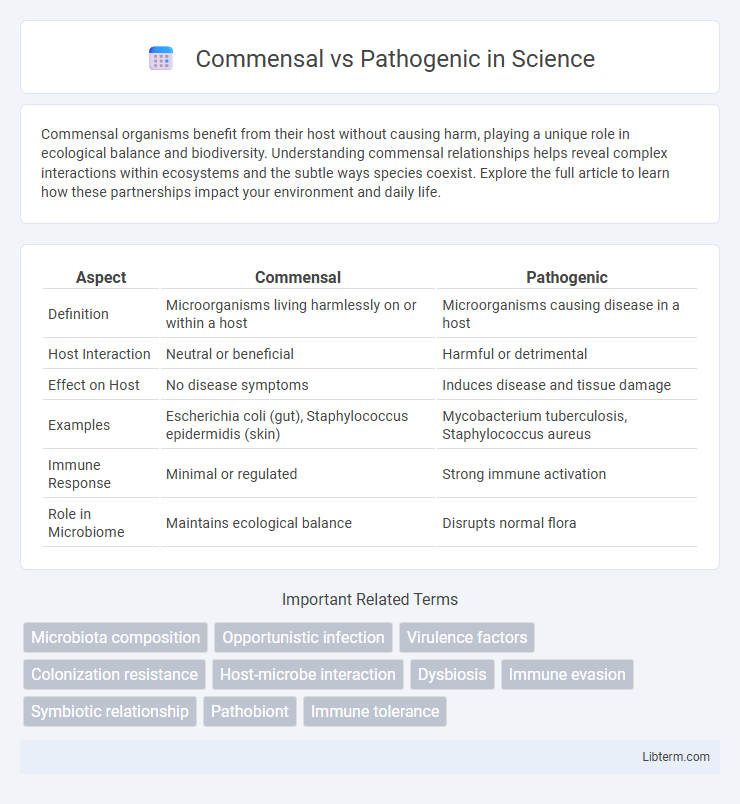Commensal organisms benefit from their host without causing harm, playing a unique role in ecological balance and biodiversity. Understanding commensal relationships helps reveal complex interactions within ecosystems and the subtle ways species coexist. Explore the full article to learn how these partnerships impact your environment and daily life.
Table of Comparison
| Aspect | Commensal | Pathogenic |
|---|---|---|
| Definition | Microorganisms living harmlessly on or within a host | Microorganisms causing disease in a host |
| Host Interaction | Neutral or beneficial | Harmful or detrimental |
| Effect on Host | No disease symptoms | Induces disease and tissue damage |
| Examples | Escherichia coli (gut), Staphylococcus epidermidis (skin) | Mycobacterium tuberculosis, Staphylococcus aureus |
| Immune Response | Minimal or regulated | Strong immune activation |
| Role in Microbiome | Maintains ecological balance | Disrupts normal flora |
Introduction to Commensal and Pathogenic Microorganisms
Commensal microorganisms are harmless or beneficial microbes that reside on or within a host without causing disease, often contributing to essential functions such as digestion and immune system modulation. Pathogenic microorganisms, in contrast, possess specific virulence factors that enable them to invade host tissues, evade immune defenses, and cause infections or diseases. Understanding the dynamic interactions between commensal and pathogenic microbes is crucial for developing targeted therapies and maintaining microbial balance for overall health.
Defining Commensal Microbes
Commensal microbes are non-harmful microorganisms that reside on or within a host organism, contributing to homeostasis and often providing essential functions such as nutrient synthesis and immune regulation. Unlike pathogenic microbes, commensals do not cause disease under normal conditions and maintain a balanced coexistence with the host's immune system. Their presence supports mucosal barrier integrity and competitively excludes potential pathogens, playing a critical role in maintaining overall health.
Understanding Pathogenic Microbes
Pathogenic microbes are microorganisms capable of causing disease by invading host tissues, evading immune responses, and producing toxins. Unlike commensal microbes that coexist harmlessly or beneficially with the host, pathogens disrupt normal physiological functions leading to infections such as bacterial pneumonia, viral influenza, and parasitic malaria. Understanding the molecular mechanisms of pathogenicity, including adhesion factors, virulence genes, and immune system interactions, is crucial for developing targeted treatments and preventive strategies.
Key Differences Between Commensal and Pathogenic Organisms
Commensal organisms coexist with their hosts without causing harm, often providing beneficial functions such as aiding in digestion or protecting against harmful microbes. Pathogenic organisms, in contrast, invade host tissues and trigger disease by disrupting normal cellular functions or evading the immune system. Key differences include their modes of interaction with the host, impact on host health, and mechanisms of survival and replication.
Mechanisms of Commensalism in Human Health
Commensal bacteria maintain a symbiotic relationship with the human host by adhering to epithelial surfaces without causing harm, outcompeting pathogens for nutrients and space through competitive exclusion. They produce antimicrobial peptides and modulate the host immune system by stimulating regulatory T cells, promoting immune tolerance and preventing inflammation. These mechanisms collectively support mucosal barrier integrity and contribute to overall host health by balancing microbial communities.
Pathogenesis: How Pathogens Cause Disease
Pathogens cause disease through mechanisms such as adhesion to host cells, invasion of tissues, and evasion of the immune system. They produce toxins, enzymes, and other virulence factors that damage host cells and disrupt normal physiological functions. The interaction between pathogen virulence determinants and host immune responses determines the severity and progression of the infection.
Transition from Commensal to Pathogen
The transition from commensal to pathogenic states in microorganisms often involves genetic mutations, environmental changes, and host immune system interactions that enable harmless commensals to express virulence factors. Biofilm formation and quorum sensing mechanisms play pivotal roles in this shift by enhancing microbial resistance and facilitating tissue invasion. Understanding these molecular and ecological triggers is crucial for developing strategies to prevent infections originating from opportunistic commensal microbes.
Impact of Microbial Balance on Immunity
Commensal microbes maintain immune homeostasis by promoting regulatory T cell development and producing antimicrobial peptides, which strengthen barrier defenses. Pathogenic microbes disrupt this balance, triggering inflammatory responses and compromising immune function. Maintaining microbial equilibrium is crucial for preventing chronic inflammation and enhancing overall immune resilience.
Clinical Implications and Disease Prevention
Commensal microorganisms play a vital role in maintaining immune homeostasis and preventing opportunistic infections, whereas pathogenic microbes trigger inflammatory responses leading to disease. Understanding the balance between commensal and pathogenic species is crucial for developing targeted therapies that enhance beneficial flora while suppressing harmful pathogens. Clinical strategies such as probiotics, prebiotics, and antimicrobial stewardship aim to preserve microbial balance, reducing the risk of infections and promoting overall health.
Future Perspectives in Microbial Research
Future perspectives in microbial research emphasize understanding the dynamic interplay between commensal and pathogenic microbes to develop precision microbiome therapies. Advances in metagenomics and single-cell sequencing technologies enable detailed mapping of microbial communities, revealing mechanisms that transition commensals into pathogens under specific environmental or host-related triggers. Integrating multi-omics data with machine learning models is expected to drive innovations in predicting microbial behavior, leading to targeted interventions that maintain microbial balance and prevent infectious diseases.
Commensal Infographic

 libterm.com
libterm.com